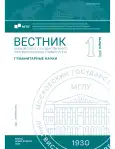Discursive Features and Suprasegmental Characteristics of Conflict Communication
- Authors: Demina M.1
-
Affiliations:
- Moscow State Linguistic University
- Issue: No 1(895) (2025)
- Pages: 45-51
- Section: Linguistics
- URL: https://journal-vniispk.ru/2542-2197/article/view/279182
- ID: 279182
Cite item
Full Text
Abstract
This study aims at identifying discursive practices and intonation characteristics indicating conflict communicative behavior. A detailed phonopragmatic analysis of the English-language conversational podcast made it possible to trace the dynamics of ideological communicative confrontation. The results of the study indicate that the communicative conflict is realized in female and male speech differently, affecting discursive features and intonational characteristics of speech. The suprasegmental design of utterances can also indicate hidden aggression and hostility of communicants, which are not explicitly reflected in the verbal component of their interaction.
About the authors
Malvina Demina
Moscow State Linguistic University
Author for correspondence.
Email: demina.malvina@gmail.com
SPIN-code: 8487-1117
Russian Federation
References
- Komalova, L. R. (2016). Interpersonal Communication: From conflict to consensus: monograph. Moscow. (In Russ.)
- Seiranyan, M. Yu. (2016). Conflict Discourse and its prosodic organization. Moscow: MPSU. (In Russ.)
- Kinderknekht, A. C. (2023). Conflict in Linguistic Researches. Nauchnyi dialog, 12(1), 45–68. (In Russ.)
- Demina, M. A., Ivanova, A. M. (2019). Temporal accommodation of communicants’ speech in the course of interaction. Vestnik of Moscow State Linguistic University. Humanities, 5(821), 47–58. (In Russ.)
- Demina, M. A. (2021). An investigation into gender specifics of communicants’ pitch attunement in natural English conversation. XLinguae, 14 (2), 142–156. 10.18355/XL.2021.14.02.11.
- Abdullina, R. E. (2024). Tactics of pitch convergence in natural British English conversation. Vestnik of Moscow State Linguistic University. Humanities, 2(883), 9–15. (In Russ.)
- Sacks, H., Schegloff, E. A., Jefferson, G. (1974). А simplest systematics for the organization of turn-taking for conversation. Language, 50(4), 696–735.
- Scott, S. (2002). Linguistic feature variation within disagreements: An empirical investigation. Text, 22(2), 301–328.
- Zakoyan, L. M. (2008). Speech aggression as a subject of linguistic scientific research. RUDN Journal of Language Education and Translingual Practices, 2, 46–52.
- Van Dijk, T. A. (1993). Principles of Critical Discourse analysis. Discourse & Society, 4, 249–283.
- Fairclough, N. (1995). Critical discourse analysis. London: Longman.
- Brown, P., Levinson, S. C. (1987). Politeness. Some universals in language usage. Cambridge University Press.
- Demina, M. A. (2014). Phonopragmatic approach to analysing television news discourse. Vestnik of Moscow State Linguistic University. Humanities, 687(1), 76–87. (In Russ.)
- Chernenko, O. (2019). Pragmatic peculiarities of the final phase of conflict interaction in fiction discourse. Lege artis. Language yesterday, today, tomorrow, IV(2), 147–153.
- Hames, D. S. (2012). Negotiation. Closing Deals, Setting Disputes, and Making Team Decisions. Sage Publication, Inc.
- Kodzasov, S. V. (2009). Issledovanija v oblasti russkoj prosodii = Studies in the field of Russian prosody. Moscow: LRC Publishing House. (In Russ.)
- Shcherbakova, L. A. (2006). Gortannyj smychnyj soglasnyj v russkom jazyke = Laryngeal consonant in the Russian language: PhD in Phylology. Moscow. (In Russ.)
Supplementary files










